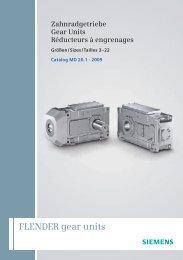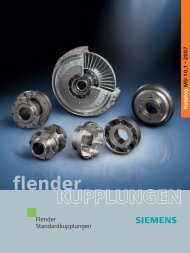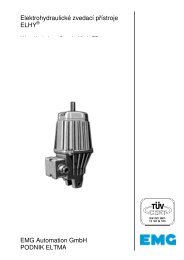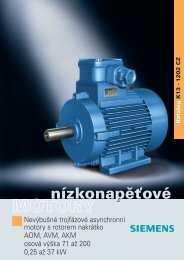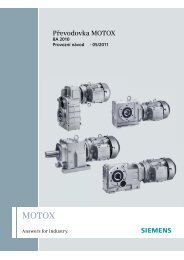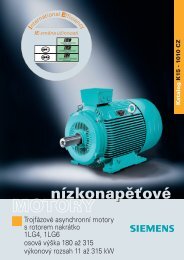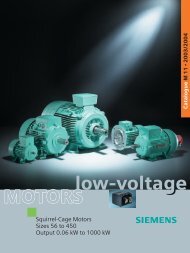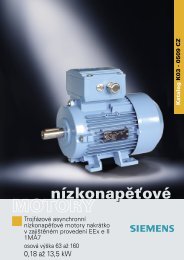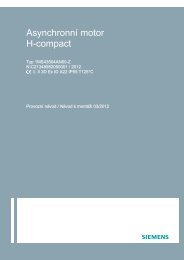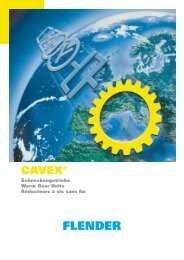Manuál elektromotorů 1LA7/1LA9 - MOTOR-GEAR as
Manuál elektromotorů 1LA7/1LA9 - MOTOR-GEAR as
Manuál elektromotorů 1LA7/1LA9 - MOTOR-GEAR as
Create successful ePaper yourself
Turn your PDF publications into a flip-book with our unique Google optimized e-Paper software.
EN<br />
NOTE: If the openings for cables and wiring in the terminal box<br />
are sealed with a ”c<strong>as</strong>t skin” (knockout), this must be removed in the<br />
appropriate manner (see Fig. 4).<br />
Care must be taken not to damage the terminal box, the terminal<br />
board, the cable connections, etc. inside the terminal box!<br />
See Fig. 4.1 for details of the screwed connections for cables and<br />
leads. An adapter must be screwed in for PTC thermistor connections!<br />
The terminal box must be sealed so that it is dust and water-tight.<br />
The system voltage and the frequency must agree with the data given<br />
on the rating plate. Voltage or frequency deviations of ±5% and ±2%<br />
respectively from the rated voltage and frequency values are permitted<br />
without needing to derate the output. The connection and<br />
arrangement of the terminal links must agree with the diagram<br />
provided in the terminal box.<br />
Connect the earthing conductor to the terminal with the marking.<br />
Wherever terminal clips are used (for example, to DIN 46282),<br />
arrange the conductors so that the clips are virtually level on both<br />
sides. This method of connection means that the ends of single<br />
conductors must be bent in the shape of a U or be fitted with a<br />
cable lug (see Fig. 6.1). This also applies to the green-yellow<br />
protective earthing conductor and the outer earthing conductor<br />
(see Fig. 6.2).<br />
Ple<strong>as</strong>e refer to Fig. 5 for the tightening torques for the screwed<br />
electrical connections - terminal board connections (except for<br />
terminal strips).<br />
The anti-condensation heater must not be switched on during<br />
operation.<br />
3.5 Checking the insulation resistance<br />
The insulation resistance of the windings must be me<strong>as</strong>ured prior<br />
to initial startup of the motor, or after long periods of storage or<br />
standstill (approx. 6 months).<br />
While the me<strong>as</strong>urement is being taken and immediately afterwards,<br />
some of the terminals carry dangerous voltages and must not be<br />
touched.<br />
Insulation resistance<br />
- The minimum insulation resistance of new, cleaned or<br />
repaired windings with respect to ground is 10 MW.<br />
- The critical insulation resistance R crit is calculated first by<br />
multiplying the rated voltage U N , e.g. 0.69 kV AC, with the<br />
constant factor (0.5 MW/kV):<br />
R crit = 0.69 kV x 0.5 MW/kV = 0.345 MW.<br />
Me<strong>as</strong>urement<br />
The minimum insulation resistance of the windings to ground is<br />
me<strong>as</strong>ured with 500 V DC. The winding temperature should then be<br />
25oC ± 15 oC. The critical insulation resistance should be me<strong>as</strong>ured with 500 V DC<br />
with the winding at operating temperature.<br />
Checking<br />
If the minimum insulation resistance of a new, cleaned or repaired<br />
motor, which h<strong>as</strong> been stored or at standstill for a prolonged period<br />
of time, is less than 10 MW, this may be due to humidity. The windings<br />
must then be dried.<br />
After long periods of operation, the minimum insulation resistance<br />
may drop to the critical insulation resistance. As long <strong>as</strong> the<br />
me<strong>as</strong>ured value does not fall below the calculated value of the<br />
critical insulation resistance, the motor may continue in operation.<br />
If it does, the motor must be stopped immediately.<br />
The cause must be determined, and the windings or winding sections<br />
repaired, cleaned or dried <strong>as</strong> necessary.<br />
3.6 Commissioning<br />
NOTE: Electromagnetic compatibility<br />
6<br />
WARNING<br />
Emitted interference: Where the torque is very<br />
uneven (the drive of a piston-type compressor, for<br />
example), the inevitable result is a non-sinusoidal<br />
motor current, whose harmonics can lead to excessive<br />
system perturbation and thus excessive emitted<br />
interference.<br />
ENGLISH<br />
In the c<strong>as</strong>e of converter-fed motors, interference is emitted to a<br />
greater or lesser degree, depending on the converter version concerned<br />
(type, interference suppression me<strong>as</strong>ures, manufacturer). The<br />
instructions of the converter manufacturer regarding electromagnetic<br />
compatibility must be heeded at all times. If the use of a shielded<br />
motor cable is recommended, the shield will have the greatest effect<br />
if it is conductively connected over a large area on the metal terminal<br />
box of the motor (with a screwed metal conduit thread). Noise<br />
voltages may occur on the sensor leads of motors with integrated<br />
sensors (e.g. PTC thermistors) <strong>as</strong> a result of the converter.<br />
If the motor is operated on a converter at speeds that exceed the<br />
rated speed, the mechanical critical speeds (safe operating speed<br />
IEC 60034-1) must be observed.<br />
Noise immunity: If the motor h<strong>as</strong> an integrated sensor (e.g. a PTC<br />
thermistor), the owner is responsible for ensuring adequate noise<br />
immunity by choosing a suitable sensor signal lead (possibly with<br />
shielding, connected like the motor supply lead) and evaluator.<br />
The data and recommendations specified in all the instructions<br />
supplied (“Information on safety and commissioning”), and in all<br />
other related instructions, must always be observed prior to<br />
commissioning!<br />
After motor installation, the brake, if fitted, should be checked for<br />
proper functioning.<br />
4 Maintenance<br />
Safety precautions<br />
DANGER<br />
Before starting any work on the motor or other<br />
equipment, particularly before opening covers over<br />
live parts, the motor must be properly isolated from<br />
the power supply. Besides the main circuits, any<br />
additional or auxiliary circuits that may be present<br />
must also be isolated.<br />
The usual "5 safety rules" (<strong>as</strong> set forth in DIN VDE<br />
0105) are:<br />
- Isolate the equipment<br />
- Take effective me<strong>as</strong>ures to prevent<br />
reconnection<br />
- Verify equipment is dead<br />
- Earth and short-circuit<br />
- Cover or fence off adjacent live parts<br />
The precautions listed above should remain in force<br />
until all maintenance work is finished and the motor<br />
h<strong>as</strong> been fully <strong>as</strong>sembled.<br />
ATTENTION<br />
The appropriate construction standards must be<br />
observed if any modifications or repairs are made to<br />
the motors listed (UL - Underwriters Laboratories Inc.<br />
or CSA - Canadian Standards Association). The<br />
markings shown on the left are used to identify these<br />
motors on their respective rating plates.<br />
NOTE: Where motors are fitted with closed condensed water<br />
openings, these should be opened from time to time to allow any<br />
accumulated condensed water to drain away.<br />
Condensed water openings should always be at the lowest point of<br />
the motor!<br />
Fitting new bearings, type of gre<strong>as</strong>e<br />
Under normal operating conditions, with horizontally mounted<br />
motors and the following coolant temperatures and motor speeds,<br />
the bearings should be changed at the intervals [h] specified below:<br />
40°C<br />
... 1800 rev/min approx. 40,000 h<br />
... 3600 rev/min approx. 20,000 h<br />
NOTE: The permissible axial and transverse forces (see Catalog)<br />
must not be exceeded!<br />
Irrespective of the number of operating hours, a motor which is in<br />
use should have its bearing replaced every 3 years because of the<br />
reduction in effectiveness of the gre<strong>as</strong>e.<br />
ã Siemens AG 2003 All Rights Reserved



